Undocuweek discussion highlights immigration, citizenship process
Justin Estep explains immigration system to audience members. The panel was part of events organized by Monarchs on the Hilltop for their Undocuweek.
Justin D. Estep, Director of Immigration Legal Services for Catholic Charities of Central Texas, gave a talk about the U.S. immigration system and the specific rights of immigrants targeted by Immigrations and Customs Enforcement (ICE) at St. Edward’s University on Wednesday Oct. 23. Estep is an immigration attorney with over 10 years of experience fighting on behalf of immigrants.
Estep began the talk by giving a brief overview of the history of the U.S. immigration system.
“The modern immigration system began after World War II,” he said.
The modern immigration system he referred to entails the requirements for immigrants to become U.S. citizens, the visa and green card system and American attitudes towards immigration.
He then divulged the characteristics of the modern immigration system, explaining that most immigrants leave their home country for family reunification. This means that they had a family member already in the U.S., which makes it much easier to emigrate because the family members are able to petition for the immigrant’s citizenship.
The second largest demographic of immigrants are those who are allowed into the U.S. because of a skill that is valuable to the U.S. economy. The smallest number consists of refugees and asylum seekers.
Estep also discussed the difference between refugees and asylum seekers. He explained that an asylum seeker is a person seeking protection due to persecution in their home country due to political opinion, membership of a certain social group or ethnicity. Estep defined refugees as immigrants who travel to another country to avoid war, natural disaster or lack of resources in their home country.
“Less than 2% of refugees in camps are placed in third party countries,” Estep said.
Refugees are usually held in camps before they can become citizens, but this process takes at least two years, and most are never granted citizenship. Refugee entrance to the U.S. has been capped at 30,000 this year down from 85,000 in 2016.
Throughout the first half of the workshop, Estep said he wanted to emphasize the difficulty in navigating the U.S. immigration system. He explained that the process is lengthy and difficult to understand, which is why immigration attorneys step in to help. He said that one of the largest problems in the immigration system is that the executive branch rather than the judicial branch controls immigration laws.
Estep then discussed what rights immigrants have when confronted with authorities. He emphasized the importance of not talking to authorities unless absolutely necessary.
Estep explained that there is “no benefit to showing anything besides your driver’s license and insurance,” during a traffic stop.
He also discussed how these rights are often abused by authorities, citing the case of an 18-year-old U.S. citizen who was racially profiled and held in an immigrant detainment facility for 30 days.
Estep then gave a few updates on immigration laws such as the public charge rule, wherein the U.S. government examines an immigrant’s wealth before granting entry. Before this law, those petitioning for an immigrant were the only parties required to show proof of wealth.
When asked about what a Trump re-election would mean for the immigration system, Estep said “it will go from bad to worse.”

Hi! I'm Ben Cardillo, I will be graduating this May with a major in Writing and Rhetoric and a minor in Photography. I grew up in Tampa, FL (go Bucs),...







